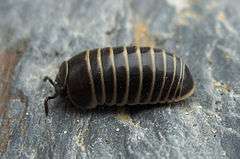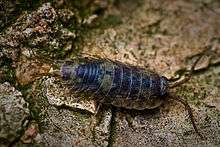Woodlouse
| Woodlouse | |
|---|---|
 | |
| Porcellio scaber (left) and Oniscus asellus (centre) living on fallen wood | |
| Scientific classification | |
| Kingdom: | Animalia |
| Phylum: | Arthropoda |
| Subphylum: | Crustacea |
| Class: | Malacostraca |
| Order: | Isopoda |
| Suborder: | Oniscidea Latreille, 1802 |
| Infraorders and sections | |
| |
A woodlouse (plural woodlice) is an isopod crustacean with a rigid, segmented, long exoskeleton and fourteen jointed limbs. Mostly they feed on dead plant material, and they are usually active at night. Woodlice form the suborder Oniscidea within the order Isopoda, with over 5,000 known species.
Woodlice in the genus Armadillidium and in the family Armadillidae can roll up into an almost perfect sphere as a defensive mechanism, hence some of the common names such as pill bug or roly-poly. Most woodlice, however, cannot do this.[1]
Common names
Common names for woodlice vary throughout the English-speaking world. A number of common names make reference to the fact that some species of woodlice can roll up into a ball. Other names compare the woodlouse to a pig.
Names include:
- "armadillo bug"[2]
- "boat-builder" (Newfoundland, Canada)[3]
- "butcher boy" or "butchy boy" (Australia,[4] mostly around Melbourne[5])
- "carpenter" or "cafner" (Newfoundland and Labrador, Canada)[6]
- "cheeselog" (Reading, England)[7]
- "cheesy bobs" (Guildford, England)[8]
- "chiggy pig" (Devon, England)[9][10]
- "doodlebug" (also used for the larva of an antlion)[11]
- "gramersow" (Cornwall, England)[12]
- "granny grey" (South Wales)[13]
- "pill bug" (usually applied only to the genus Armadillidium)[14]
- "potato bug"[15]
- "roll up bug"[16]
- "roly-poly"[15]
- "sow bug"[17]
- "slater" (Scotland, Northern Ireland, New Zealand and Australia)[18][19][20]
- "wood bug" (British Columbia, Canada)[21]
Description and life cycle
The woodlouse has a shell-like exoskeleton, which it must progressively shed as it grows. The moult takes place in two stages; the back half is lost first, followed two or three days later by the front. This method of moulting is different from that of most arthropods, which shed their cuticle in a single process.
A female woodlouse will keep fertilised eggs in a marsupium on the underside of her body until they hatch into offspring that look like small white woodlice curled up in balls. The mother then appears to "give birth" to her offspring. Females are also capable of reproducing asexually.[22]
Despite being crustaceans like lobsters or crabs, woodlice are said to have an unpleasant taste similar to "strong urine".[22]
Pillbugs and pill millipedes


Pillbugs (woodlice of the family Armadillidiidae, also known as pill woodlice) can be confused with pill millipedes of the order Glomerida.[23] Both of these groups of terrestrial segmented arthropods are about the same size. They live in very similar habitats, and they can both roll up into a ball. Pill millipedes and pillbugs appear superficially similar to the naked eye. This is an example of convergent evolution.
Pill millipedes can be distinguished from woodlice on the basis of having two pairs of legs per body segment instead of one pair like all isopods. Pill millipedes have twelve to thirteen body segments, with a large shield-like posterior segment, whereas woodlice have eleven, and small posterior segments. In addition, pill millipedes are smoother, and resemble normal millipedes in overall colouring and the shape of the segments.
Ecology

Living in a terrestrial environment, woodlice breathe through trachea-like lungs in their paddle-shaped hind legs (pleopods), called pleopodal lungs. Woodlice need moisture because they rapidly lose water by excretion and through their cuticle, and so are usually found in damp, dark places, such as under rocks and logs, although one species, Hemilepistus reaumuri, inhabits "the driest habitat conquered by any species of crustacean".[24] They are usually nocturnal and are detritivores, feeding mostly on dead plant matter.
A few woodlice have returned to water. Evolutionary ancient species are amphibious, such as the marine-intertidal sea slater (Ligia oceanica), which belongs to family Ligiidae.
Other examples include some Haloniscus species from Australia (family Scyphacidae), and in the northern hemisphere several species of Trichoniscidae and Thailandoniscus annae (family Styloniscidae). Species for which aquatic life is assumed include Typhlotricholigoides aquaticus (Mexico) and Cantabroniscus primitivus (Spain).[25]

Woodlice are eaten by a wide range of insectivores, and some animals are known to prey exclusively on woodlice, for example, spiders of the genus Dysdera, such as the woodlouse spider Dysdera crocata,[17] and land planarians of the genus Luteostriata, such as Luteostriata abundans.[26]
Woodlice as pests
Although woodlice, like earthworms, are generally considered beneficial in gardens for their role in controlling pests,[27] producing compost and overturning the soil, they have also been known to feed on cultivated plants, such as ripening strawberries and tender seedlings.[28]
Woodlice can also invade homes en masse in search of moisture and their presence can indicate dampness problems.[29] They are not generally regarded as a serious household pest as they do not spread disease and do not damage sound wood or structures.
British Isles
There are over 45 native or naturalised species of woodlouse in the British Isles, ranging in colour and in size (3–30 millimetres or 0.1–1.2 inches). Of these 45 species, only five are common: Oniscus asellus (the common shiny woodlouse), Porcellio scaber (the common rough woodlouse), Philoscia muscorum (the common striped woodlouse), Trichoniscus pusillus (the common pygmy woodlouse), and Armadillidium vulgare (the common pill bug).
Classification
- Infraorder/Section Diplocheta
- Infraorder Holoverticata
- Section: Tylida
- Section: Microcheta
- Section: Synocheta
- Buddelundiellidae
- Schoebliidae
- Styloniscidae
- Titaniidae
- Trichoniscidae
- Tunanoniscidae
- Section: Crinocheta
- Agnaridae
- Alloniscidae
- Armadillidae
- Armadillidiidae
- Balloniscidae
- Bathytropidae
- Berytoniscidae
- Cylisticidae
- Delatorreidae
- Detonidae
- Eubelidae
- Halophilosciidae
- Olibrinidae
- Oniscidae
- Philosciidae
- Platyarthridae
- Porcellionidae
- Pudeoniscidae
- Rhyscotidae
- Scleropactidae
- Scyphacidae
- Spelaeoniscidae
- Stenoniscidae
- Tendosphaeridae
- Trachelipodidae
References
- ↑ "Suborder Oniscidea". Bug Guide. March 25, 2009.
- ↑ Dale Mayer (2010). The Complete Guide to Companion Planting: Everything You Need to Know to Make Your Garden Successful. Atlantic Publishing Company. p. 88. ISBN 9781601383457.
- ↑ "Dictionary of Newfoundland English – boat n". Retrieved February 27, 2012.
- ↑ "Bugs Bugs Bugs!" (PDF). Museum Victoria. Retrieved March 30, 2010.
- ↑ "Australian Word Map". Macquarie Dictionary. Macmillan Publishers, Australia. 2014. Retrieved February 8, 2015.
- ↑ "Dictionary of Newfoundland English – carpenter n". Dictionary of Newfoundland English. Retrieved September 29, 2016.
- ↑ Paul Kerswill. "The sound of Reddin". BBC. Retrieved September 17, 2006.
- ↑ James Chapple. "Everyone in Guildford is calling wood lice 'cheesy bobs' and it's brilliant". Trinity Mirror Group. Retrieved January 15, 2016.
- ↑ "BBC Devon: Voices". BBC Devon. Retrieved June 25, 2012.
- ↑ "365 Urban Species. #093: Woodlouse". The Urban Pantheist. Retrieved January 18, 2009.
- ↑ "Sow bug". Dictionary.com Unabridged (v 1.0.1). 2006. Retrieved August 17, 2006.
- ↑ Matthew Francis (2004). Where the People Are: Language and Community in the Poetry of W.S. Graham. Salt Publishing. ISBN 1-876857-23-4.
- ↑ "Pillbugs". Niles Biological, Inc. Retrieved June 8, 2016.
- ↑ Bill Amos (August 10, 2002). "Little armored tanks". Caledonian-Record.
- 1 2 Bert Vaux & Scott A. Golder. "Dialect Survey". Harvard University. Archived from the original on September 3, 2006. Retrieved September 30, 2006.
- ↑ Gail Smith-Arrants (March 20, 2004). "You say potato bug, I say roly-poly, you say…" (PDF). Charlotte Observer.
- 1 2 Bruce Marlin. "Common Woodlouse, Sow Bug, Pillbug". North American Insects and Spiders. Retrieved February 10, 2009.
- ↑ Mairi Robinson, ed. (1987). The Concise Scots Dictionary (3rd ed.). Aberdeen: Aberdeen University Press. p. 628. ISBN 0-08-028492-2.
- ↑ Maria Minor & A. W. Robertson (2006). "Guide to New Zealand soil invertebrates: Isopoda". Massey University. Retrieved May 13, 2007.
- ↑ Josh Byrne (2009). "Fact Sheet: Slater Control". Retrieved May 22, 2012.
- ↑ "Wood Bug". Vancouver Sun. November 26, 2007.
- 1 2 "How Now, Sow Bug?," Discover, August 1999, 68. Available from: https://msvictorialin.wikispaces.com/file/view/sow-bug-article.pdf
- ↑ "Pill woodlouse (Armadillidium vulgare)". ARKive.org. Retrieved February 13, 2009.
- ↑ Rod Preston-Mafham & Ken Preston-Mafham (1993). "Crustacea. Woodlice, crabs". The Encyclopedia of Land Invertebrate Behavior. MIT Press. p. 161. ISBN 978-0-262-16137-4.
- ↑ Ivo Karaman (2003). "Macedonethes stankoi n. sp., a rhithral oniscidean isopod (Isopoda: Oniscidea: Trichoniscidae) from Macedonia" (PDF). Organisms Diversity & Evolution. 3 (8): 1–15. doi:10.1078/1439-6092-00054.
- ↑ Prasniski, M. E. T.; Leal-Zanchet, A. M. (2009). "Predatory behavior of the land flatworm Notogynaphallia abundans (Platyhelminthes: Tricladida)". Zoologia (Curitiba). 26 (4): 606. doi:10.1590/S1984-46702009005000011.
- ↑ Bailey, Pat (March 15, 1999). "Humble Roly-Poly Bug Thwarts Stink Bugs in Farms, Gardens". UC Davis News Service.
- ↑ Phillip E. Sloderbeck (2004). "Pillbugs and sowbugs" (PDF). Kansas State University.
- ↑ "Sow Bugs". Pestcontrolcanada.com. Retrieved August 17, 2012.
External links
Further reading
- Christian Schmidt & Andreas Leistikow (2004). "Catalogue of the terrestrial Isopoda (Crustacea: Isopoda: Oniscidea)" (PDF). Steenstrupia. 28 (1): 1–118. (lists all genera published up to the end of 2001)